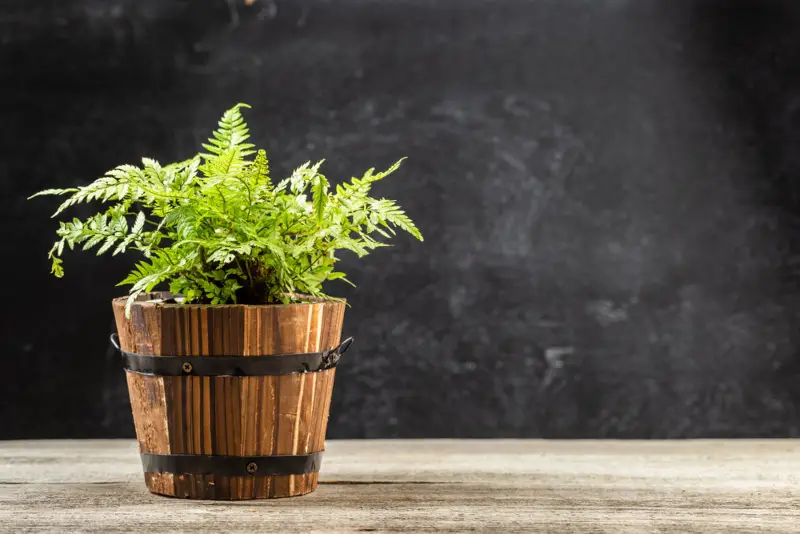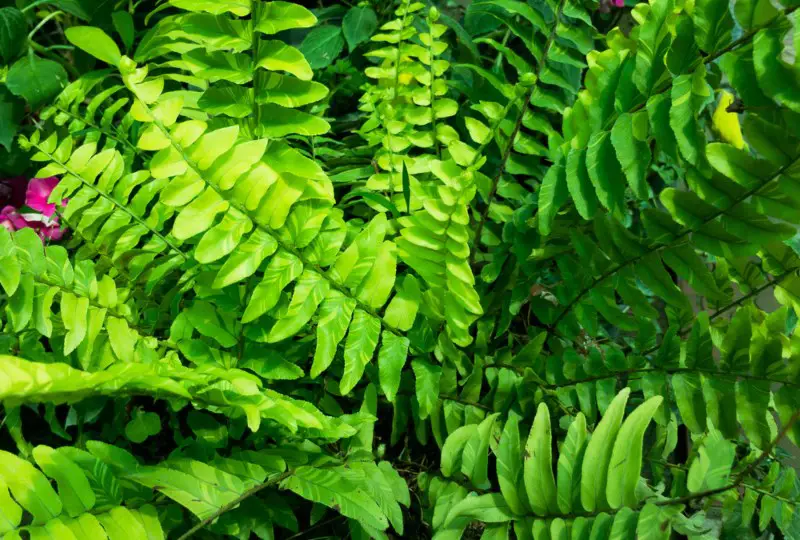
Ferns are a very popular houseplant due to their tolerance for lower light conditions and unique fringed look. They look great just about anywhere, but to show off their fronds, it helps to keep them up high to give them plenty of room to drape.
One popular way of showing off a healthy fern is by keeping it in a hanging basket. Hanging your potted plants can help you save the table, counter, or floor space and make them easier to care for. Here are ten ferns that are great for hanging in baskets.
Boston Fern (Nephrolepis exaltata ‘Bostoniensis’)

The long, arching fronds of the Boston Fern make it the quintessential hanging basket fern. They can grow up to four feet long, spilling majestically over the edges of a hanging basket. They prefer brighter light than most ferns but still won’t tolerate direct sun, so keep them a few feet back from your windows and doors.
Boston Ferns are more drought-tolerant than most ferns but still prefer relatively consistent moisture. Hanging baskets can lose moisture faster than other pots, but you can help your Boston Fern retain moisture longer by double-potting it inside a larger pot lined with moist sphagnum moss.
The Boston Fern, in particular, is very prone to mutations, resulting in a wide range of variations descended from this well-known fern species, such as the Dallas Fern and Tiger Fern.
Macho Fern (Nephrolepis biserrata)

Formerly a cultivar of the Boston Fern, the Macho Fern is now considered its own species. It’s a perennial fern native to Florida that grows wild in Hawaii, Puerto Rico, and the Virgin Islands. Sometimes also known as the Giant Sword Fern, it proliferates invasively outdoors under ideal conditions and can grow up to five feet tall in the wild.
It will only grow about half that size in a pot, but it still makes a statement in a hanging basket. Like most ferns, it likes lots of moisture and lots of shade. You can take it outside when the weather is warm but bring it indoors at the first sign of a cold front. This tropical plant hates the cold.
Lady Fern (Athyrium filix-femina)

This deciduous fern is a common plant that grows wild throughout the northern hemisphere. Outdoors, they spread rampantly by spores in almost all conditions, but they stay safely contained indoors.
Like most ferns, the Lady Fern prefers more shade than sun, but as long as they have enough moisture, they’ll tolerate more brightness than other ferns.
Asparagus Fern (Asparagus densiflorus)

Though it strongly resembles a fern, the Asparagus Fern is not a true fern. Unlike true ferns, which reproduce by spores, the Asparagus Fern reproduces by seeded fruits eaten and dispersed by birds.
Native to South Africa, the Asparagus Fern has escaped from cultivation and is now considered an invasive species in Florida. It tolerates more heat and drought than true ferns and is a great beginner-friendly “fern.”
Staghorn Fern (Patycerium bifurcatum)

The Elkhorn Fern is the most alien-looking plant on this list. Its fronds resemble the horns of an adult stag or elk, which is where the plant gets its namesake. Fully grown, it can measure as much as three feet across.
This stunning ornamental fern looks otherworldly in a hanging basket. It makes a great conversation piece among plant lovers and plant novices alike.
Hay Scented Fern (Dennstaedtia punctilobula)

This fern gets its common name from the subtle scent it gives off when its leaves are brushed or crushed – like freshly mown hay. It looks similar to other ferns, like the Lady Fern, but its fragrance makes it distinguishable.
Its fronds are dense and lush, covered in delicate hairs. This fern likes a bit more light than most, so put it in a window where it can get some direct sunlight in the morning.
Kimberley Queen Fern (Nephrolepis obliterata)

The Kimberly Queen Fern, sometimes mistaken for the Boston Fern, has more upright fronds than its famous cousin. Even without the characteristic arched fronds, though, this fern looks lovely in a hanging basket.
According to NASA, this fern is adept at filtering out indoor air pollutants like formaldehyde and toluene. In addition, the Kimberley Queen Fern is one of the easiest ferns to care for, tolerating drier indoor air than many of its relatives. It’s also surprisingly drought resistant, as long as it stays shaded.
Delta Maidenhair Fern (Adiantum raddianum)

Maidenhair Ferns like the Delta Maidenhair enjoy much more humidity than the Boston Fern and similar varieties. As a result, it requires frequent watering, and unless you live in a highly humid climate, you’ll want to mist its leaves fairly regularly, too.
For added humidity, hang your Maidenhair Fern in your bathroom, where it can soak up the humidity from your shower. It also does well in a terrarium, which helps to retain some of that moisture. Its fronds can grow about two feet tall and arch similar to Boston and other varieties when mature.
Tiger Fern (Nephrolepis exaltata ‘Tiger Fern’)

A natural mutation of the famous Boston Fern caused it to develop variegated tiger stripes, from which the Tiger Fern gets its nickname. These stripes are semi-random in pattern and size, with wholly light-colored leaves interspersed amongst variegated and solid green fronds.
Like its parent, the Boston Fern, Tiger Ferns like slightly brighter light conditions than most ferns but produce more dramatic color patterns with less light. Water frequently and fertilize monthly for best results, and try to keep it in as humid a room as possible, such as in or near the shower or bathroom.
Dallas Fern (Nephrolepis exaltata ‘Dallas Fern’)
This descendent of the Boston Fern is a more compact, beginner-friendly variety. It doesn’t grow as flamboyantly and aggressively as the Boston Fern, making it a better fit for smaller containers and spaces.
Like most ferns, Dallas Ferns like consistently moist soil, high humidity, and low light. The lower the light, the less frequently you’ll need to water it, but it will also grow more slowly with too little light. A shaded Dallas Fern requires very little maintenance, but monthly fertilization (except in winter) will help your fern thrive.













